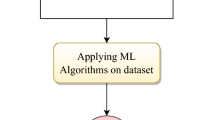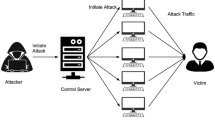Abstract
With the changing times, the faces of dangers have also changed. The way is still through disguise, but the medium is now digital. And out of all the dangers, the most dangerous threat is that of botnets because their botmaster not only takes control of millions of millions of systems in his/her hands, but also uses them for executing his terrible plans. Botnet-based attacks can be of different threat vectors such as spamming in case of web-account abuse attack or botnets causing DDoS attacks. Many techniques have been found to detect botnets such as detecting botnets from anomalies in network behavior, using NetFlow to recognize these anomalies or graphically understanding the network traffic, but the specialty about botnets is that they change their network traffic behavior every time they launch an attack. Therefore, this research is based on finding out the ability of popular machine learning classifiers to detect botnets so that servers and firewalls can use the best of these models to protect themselves from botnets. In this research, we have used decision tree, logistic regression, support vector machine, Gaussian Naive Bayes, and K-means clustering machine learning classifiers to train them using CTU-13 dataset and finally calculating their accuracy to detect botnets. And as a result, the ability of the decision tree to detect the changing behavior of botnets has been found to be more than that of the others.
Access this chapter
Tax calculation will be finalised at checkout
Purchases are for personal use only
Similar content being viewed by others
References
Mustafa Alshamkhany and et.al., Botnet Attack Detection using Machine Learning,2020 14th International Conference on Innovations in Information Technology (IIT),17-18 Nov. 2020. DOI: 10.1109/IIT50501.2020.9299061
S. S. C. Silva, R. M. P. Silva, R. C. G. Pinto, and R. M. Salles, “Botnets: A survey,” Comput. Networks, vol. 57, no. 2, pp. 378–403, 2013, doi: https://doi.org/10.1016/j.comnet.2012.07.021.
S. Amina, R. Vera, T. Dargahi, and A. Dehghantanha, “A Bibliometric Analysis of Botnet Detection Techniques.”
A. Lohachab and B. Karambir, “Critical Analysis of DDoS — An Emerging Security Threat over IoT Networks,” vol. 3, no. 3, 2018.
R. Hallman, J. Bryan, G. Palavicini, J. Divita, and J. Romero-mariona, “IoDDoS — The Internet of Distributed Denial of Service Attacks : A Case Study of the Mirai Malware and IoT-Based Botnets IoDDoS —The Internet of Distributed Denial of Service Attacks A Case Study of the Mirai Malware and IoT-Based Botnets,” no. April 2017.
A. Al-nawasrah and S. Arabia, A Survey of Fast Flux Botnet Detection With Fast Flux Cloud Computing, vol. 10, no. 3. 2020.
Y. Meidan et al., “N-BaIoT-Network-based detection of IoT botnet attacks using deep autoencoders,” IEEE Pervasive Comput., vol. 17, no. 3, pp. 12–22, 2018, doi: https://doi.org/10.1109/MPRV.2018.03367731.
Fadlullah ZM, Taleb T, Vasilakos AV, Guizani M, Kato N. DTRAB: combating against attacks on encrypted protocols through traffic-feature analysis. IEEE/ACM Trans Netw (TON). 2010;18(4):1234–47.
S. Almutairi, S. Mahfoudh, S. Almutairi, and J. S. Alowibdi, “Hybrid Botnet Detection Based on Host and Network Analysis,” J. Comput. Networks Commun., vol. 2020, 2020, doi: https://doi.org/10.1155/2020/9024726.
Argus (audit record generation and utilization system); 2016. http://www.qosient.com/argus Accessed 21 Feb 2016.
S. Chowdhury et al., “Botnet detection using graph-based feature clustering,” J. Big Data, vol. 4, no. 1, Dec. 2017, doi: 10.1186/s40537-017-0074-7.
S. Garcia et al., “An empirical comparison of botnet detection”, in Computers and Security, vol. 45, pp. 100–123, Sep. 2014, doi: https://doi.org/10.1016/j.cose.2014.05.011
Vishwakarma, Anand Ravindra, "Network Traffic Based Botnet Detection Using Machine Learning"(2020). Master's Projects.917. DOI: https://doi.org/10.31979/etd.4nd6-m6hp
Author information
Authors and Affiliations
Editor information
Editors and Affiliations
Rights and permissions
Copyright information
© 2023 The Author(s), under exclusive license to Springer Nature Switzerland AG
About this paper
Cite this paper
Rai, S., Sajidha, S.A., Nisha, V.M., Mahalakshmi, B. (2023). Using Machine Learning to Detect Botnets in Network Traffic. In: Misra, R., Omer, R., Rajarajan, M., Veeravalli, B., Kesswani, N., Mishra, P. (eds) Machine Learning and Big Data Analytics. ICMLBDA 2022. Springer Proceedings in Mathematics & Statistics, vol 401. Springer, Cham. https://doi.org/10.1007/978-3-031-15175-0_24
Download citation
DOI: https://doi.org/10.1007/978-3-031-15175-0_24
Published:
Publisher Name: Springer, Cham
Print ISBN: 978-3-031-15174-3
Online ISBN: 978-3-031-15175-0
eBook Packages: Mathematics and StatisticsMathematics and Statistics (R0)




